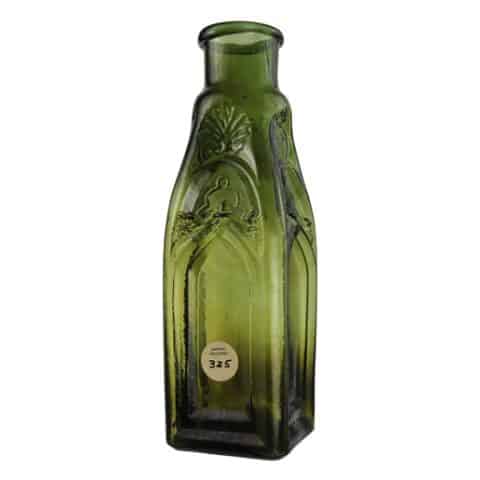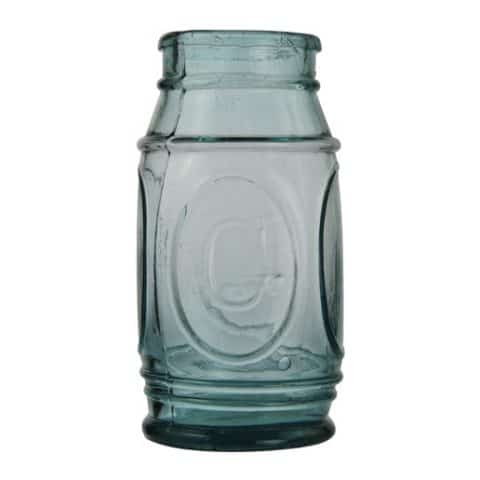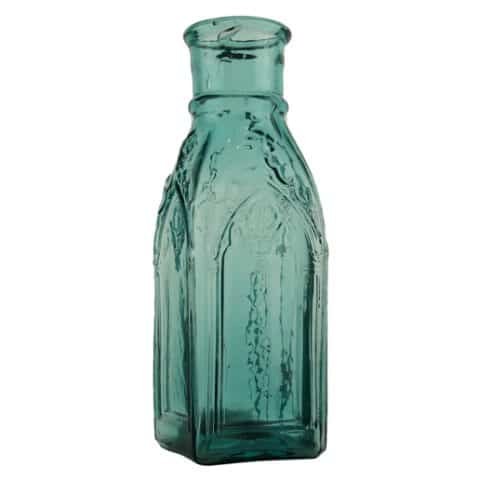Cathedral Pickle – Gardner 325
Cathedral Pickle
Clock Face & Shell Pattern
Gardner Collection 325
Charles B. Gardner, New London, Connecticut
Yellow-Green Gothic Style Quart
Provenance: Lou Pellegrini Collection

This absolutely stunning pickle bottle with a round “Gardner Collection 325” auction sticker is from what many consider the most important antique bottle collection ever assembled. The collection was eventually auctioned and the sales occurred on September 25, 26, and 27, 1975, and November 20, 21, and 22, 1975 at Robert W. Skinner Inc, in Bolton Massachusetts. The hard-bound Norman C. Heckler Gardner Collection auction book was the culmination of 3,000 hours of labor over a period of 12 weeks and has become with time, a necessary tool for collectors and dealers alike.



From the inside front cover book jacket, “For the amateur and expert alike, the Charles B. Gardner bottle collection represents the finest and best-known personal collection of its type in the United States. The product of some 46 years of assembling by an expert with a deep knowledge of the art of glass-making, and an abiding love for man’s expression of beauty and utility in glass, it is a rare example of the great variety available to the bottle collector.”
For the amateur and expert alike, the Charles B. Gardner bottle collection represents the finest and best-known personal collection of its type in the United States.
Norman C. Heckler, Skinner, Inc.
“The Gardners have generously and graciously shared their home and time with interested collectors from throughout the country who have viewed the display of 3,200 bottles in an effort to study and appreciate for themselves the range and diversity of this remarkable collection. Never before, and perhaps never again in American bottle collecting, will such a variety of bottles be assembled and made available to the collector.”

The white circular Gardner Collection 325 sticker represents the lot number in the auction catalog that simply reads, “325. Food, pickle, square with cathedral arches and fancy design, quart, yellow green, rolled collared mouth – smooth base. (Plate XVI).” When looking at the referenced color plate, our subject pickle is one of seventeen bottles on the page, no more than an inch in height. In the Price List and Addenda in the back of the catalog, you see that the pickle bottle sold for the handsome sum of $600.

This rare, probably New England quart mold is not seen often though we are aware that there was an example in the Burton Spiller collection (recently added to the museum). The square Gothic bottle follows a cathedral design with four sides with chamfered corners. The glass color is yellow-green with olive striations. There is a long, slightly double-ogee shoulder sloping to a wide cylindrical neck with a round collar. The bottle has a smooth chamfered base with a round recessed circle. There is a second later-applied sticker reading “BKNN Toms” within the base, though the meaning is unknown.
Each side has elaborate recessed Gothic arches and triple recessed beveled vertical windows with an ogival or arced top. Pointed Lancet arches are used on cathedral pickle bottles to create narrow verticle window panels. In this case, the four panels are smooth and would have been where a label was placed. The top ogival arch has a pair of repeated opposite images, one a debossed scalloped shell and the other a clock face supported by a fleur-de-lis. Beneath are elaborate decorative multifoils above the arched windows. The bottle was made in three sizes, 8-5/8 inches, 11 inches, and 13-½ inches.
See more Gothic-style bottles in the museum Food & Sauces Gallery: Cathedral Pickle Jar – Hexagonal and Willington Cathedral Pickle.
Primary Image: The Gardner 325 Cathedral Pickle imaged on location by the FOHBC Virtual Museum west coast studio led by Gina Pelligrini.
Support Image: Auction Lot 157: Clock Face and Shell Pattern, Cathedral Pickle Jar, 1860 – 1870. Strong, medium green coloration, square with beveled corners, Cathedral panels with fancy ogival arches below circular depression for a clock face on two sides, and a clam shell on the alternating sides, sheared mouth with applied ring – smooth base, ht. 8 5/8″, pristine perfect. Rich, strong color, believed to be one of only three known in this color and size. This is the much harder-to-find small size. A premier example of this fantastic pickle jar, in a considerably deep shade than normally encountered. The small 8 5/8″ size is really a very different mold design from the 11″ or 13 ½” examples. Although referred to colloquially as the ‘Clock and Shell pattern’, as noted, this smaller size does not have the actual clock face with hands, but rather a circular depression where the clock would normally be. In addition, the designs on the shoulders above the cathedral arches are also very different. – John Pastor, American Glass Gallery, Auction #30
Support Image: Auction Lot 158: Clock Face and Shell Pattern, Cathedral Pickle Jar, 1860 – 1870. Beautiful, light-to-medium green coloration, square with beveled corners, Cathedral panels with fancy ogival arches below clock faces on two sides and a large clamshell on the alternating sides, sheared mouth with applied ring collar – smooth base, ht. 11″, near mint; (a 1/8″ partially open bubble, a little light interior milkiness near base). Zumwalt, p. 457. A very scarce, desirable mold. Ex. Dr. Burton Spiller collection. A great example of this difficult-to-find pickle jar, nice green coloration, outstanding provenance. At 11″, this is the middle of three sizes. This example definitely brought a premium in the Spiller sale, and deservedly so! – John Pastor, American Glass Gallery, Auction #30
Support Image: Auction Lot 118: Cathedral Pickle Jar, (Zumwalt #457), American, ca. 1850 – 1865, deep emerald green, 10 5/8”h, smooth base, outward rolled lip, original cork closure. Pristine perfect condition with a strong impression and in an incredible (and extremely rare) deep green color. This is the desirable ‘clock face and clam shell’ embossed jar that is normally seen only in aqua. It’s been quite some time since we’ve had the privilege of offering a cathedral pickle jar of this quality! – Jim Hagenbuch, Glass Works Auctions, Auction #163
Support: Reference to American Bottles in the Charles B. Gardner Collection by Norman C. Heckler, Robert W. Skinner Inc., Bolton, Massachusetts, 1975.
Support: Reference to Ketchup Pickles Sauces – 19th Century Food in Glass by Betty Zumwalt
Support: Reference to American Bottles and Flasks and Their Ancestry by Helen McKearin and Kenneth M. Wilson, Crown Publishers Inc., New York, 1978.
Join the FOHBC: The Virtual Museum is a project of the Federation of Historical Bottle Collectors (FOHBC). To become a member.
k
















































